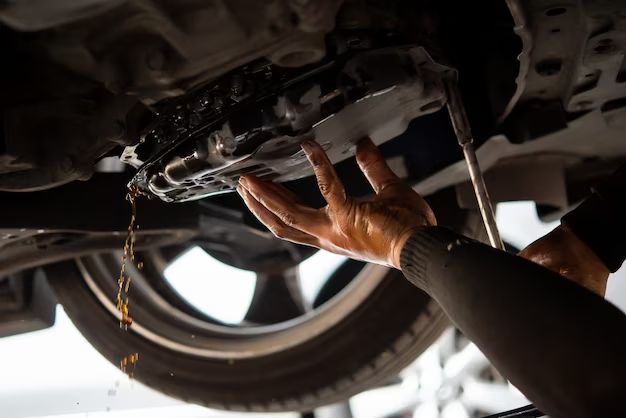Pumping out transmission fluid is a common maintenance procedure for many vehicle owners. However, there are some important safety considerations to keep in mind when doing this task. In this article, we will examine if it is safe to pump out transmission fluid, look at the potential risks, and provide tips for doing it safely.
Page Contents
What does pumping out transmission fluid involve?
Pumping out transmission fluid involves using a fluid transfer pump to remove used fluid from the transmission pan or drain plug. This is done to replace old, contaminated fluid with new fluid. Some key steps in the process include:
- Raise the vehicle up safely using jack stands or a lift
- Place a drain pan under the transmission
- Locate the transmission drain plug or pan bolts
- Use the fluid transfer pump to draw out the old fluid through the drain
- Replace the drain plug or pan bolts when finished
- Refill the transmission with new fluid to the proper level
Is it safe to DIY pump out transmission fluid?
Pumping out transmission fluid yourself does carry some safety risks. Here are some factors to consider regarding DIY safety:
- No specialty tools or pits – Most DIYers do not have access to auto shop pits or transmission fluid exchangers. This can make the process more difficult and increase safety risks.
- Heavy components – Transmission pans can weigh upwards of 30 pounds when full of fluid. Safely supporting the pan and handling the weight requires care.
- Burns – Transmission fluid can be hot, in the range of 175°F to over 200°F straight from the engine. Caution is needed to avoid burns.
- Eye injury – Pressurized fluid can cause injury if sprayed directly into eyes. Eye protection is essential.
- Toxic exposure – Transmission fluid contains potentially hazardous chemicals that can irritate skin and eyes.
- Fire hazard – Spilled, hot transmission fluid can create a fire hazard and should be addressed immediately.
- Environmental impact – Safe fluid disposal is required and spills must be cleaned thoroughly.
While do-it-yourself pumping does carry risks, being prepared, taking proper precautions, and working slowly and carefully can reduce the hazards.
Tips for safe DIY transmission fluid replacement
If you decide to pump your transmission fluid yourself, following certain best practices can help mitigate risks:
- Use jack stands – Never get under a vehicle supported only by a jack. Use jack stands for stability.
- Avoid hot fluid – Let the transmission cool completely before starting, ideally overnight.
- Wear eye protection – Have safety glasses or goggles on to protect your eyes.
- Use gloves – Wear thick, chemical-resistant gloves to avoid skin exposure.
- Check for leaks – Inspect transmission seals, gaskets, and hoses for any leaks beforehand.
- Work slowly – Avoid rushing and take your time to reduce spills or mistakes.
- Use a pump – A fluid transfer pump helps safely empty the pan without huge spills.
- Support the pan – Have a transmission jack or other support to safely hold the pan’s weight.
- Torque bolts – Tighten pan bolts to the specified torque with a torque wrench.
- Dispose of fluid properly – Collect old fluid in approved containers and recycle it responsibly.
- Check fill level – Measure and fill the transmission precisely to the indicated dipstick level.
Professional transmission fluid replacement
For many vehicle owners, having the transmission fluid professionally replaced at a shop may be the safest option. Benefits of professional service can include:
- Proper tools and pits – Shops have underground pits for easy access and fluid exchangers that simplify the process.
- Expertise – Technicians are trained and experienced performing fluid replacements regularly.
- Fluid recycling – Shops have the ability to properly recycle used fluid.
- Adjustments – The transmission can be inspected for any needed adjustments.
- Cost – DIY savings are usually minimal versus paying a shop to take on the risks.
- Convenience – You avoid having to dispose of hazardous fluid yourself.
- Peace of mind – Risks of injury or costly mistakes are eliminated.
For many owners, paying a professional for a transmission fluid change provides valuable peace of mind and convenience.
Conclusion
Pumping out old fluid and refilling the transmission is vital maintenance for the health of the transmission. While it can be done DIY, there are considerable risks involved, from handling hot fluid and heavy components to proper disposal. For those not equipped with specialty auto tools and experience, having the fluid professionally replaced is generally the safest option, despite the slightly higher cost. Carefully weighing the risks and following all precautions is critical for those doing it themselves. Proper transmission fluid replacement, whether DIY or professional, allows your transmission to operate safely for thousands of miles to come.
| DIY Transmission Fluid Replacement | Professional Replacement |
|---|---|
|
|
